This is my final project for Queer Liberation Theologies with Dr. Córdova Quero (Fall 2020). I have chosen to present the materials learned over the course of this class via a mixed media blog in hopes of providing those engaging with multiple access points an opportunity to both understand and interact with some of the wealth of information I gained over the semester.
Don't wanna be here? Send us removal request.
Text
A Visual Representation of What I Have Learned: Conclusion
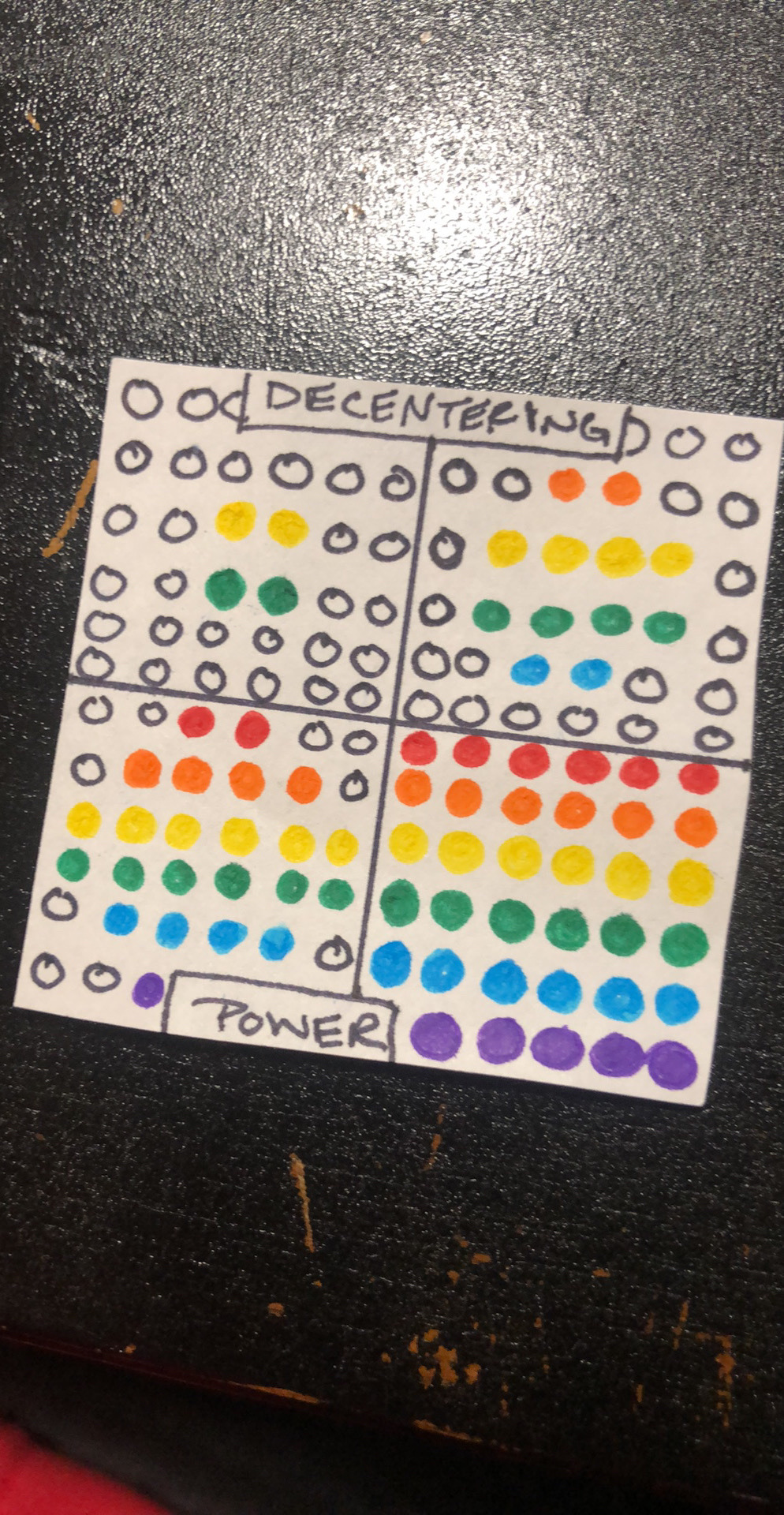
I wanted to, as a final piece, create a representation of what I learned over the course of this semester. This is also the photo I chose to use for the blog’s profile picture, so it may already look familiar to you. After sitting with some of the course materials, and combining what I learned from them with what I have learned in past queer theology courses, I decided to challenge myself to draw what I envisioned to be a representation of queerness that honors wisdom and perspectives of the tradition that I have been studying. To me, understanding queer perspectives requires a dedication, at least for me and possibly others of you coming from a western context, to decentering power. This is true on several levels - I needed to decenter my privileging of Western theology, the language and labels I was affixing to people and concepts, my biases, and so much more in order to be able to take in the information I was receiving in this course.
The square should be viewed starting in the top, left corner, with just four circles bubbled in. I wanted to illustrate both my own limited understanding of other perspectives and provide a visual example of what it looks like to exclude more diverse voices from a conversation. As you progress from top left to top right to bottom left and then finish in the bottom right corner, you not only walk with me on my journey outside of myself to a more inclusive understanding of queer liberation theologies throughout the world. You also get to see how much more interesting the picture looks when you add different voices and perspectives to the conversation. I hope that, after reading this blog, you feel better equipped to engage with and understand theologies across cultures and traditions and, further, are excited to do so!
0 notes
Photo
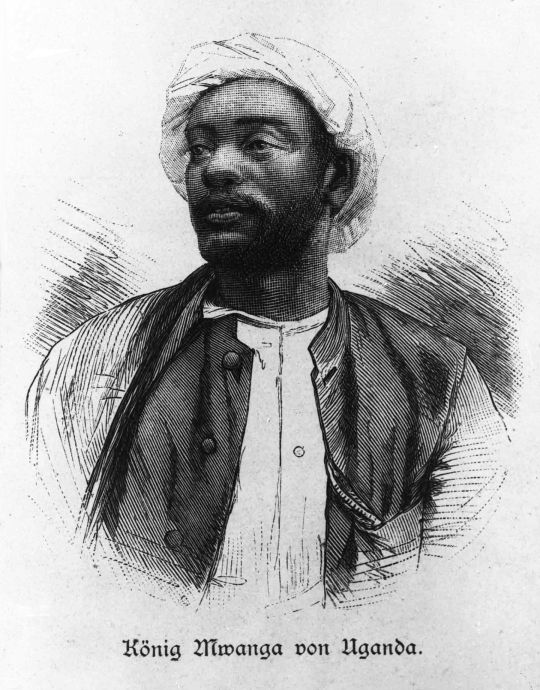
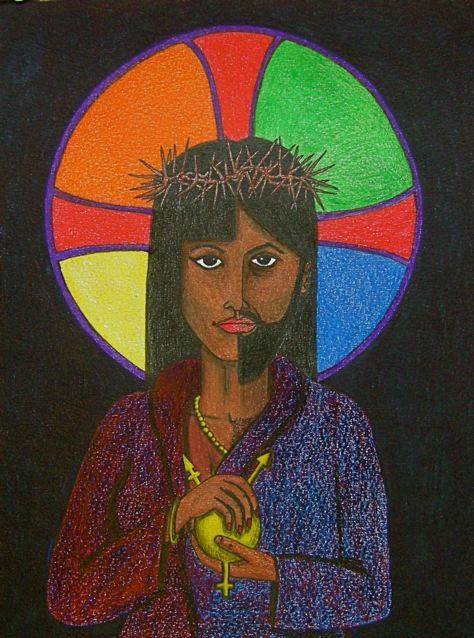
The first picture is of King Mwanga of Buganda. Today, many consider him to have been bisexual and potentially polyamorous because of his relationships with pages in his court and his marriage to a woman in which he fathered several children. (Public Domain/Wikimedia Commons)
The second work of art is titled Neither - David Hayward. It depicts an African Jesus who is fluid, at least in gender identity, and one could presume sexual as well. It speaks to a more nuanced understanding of gender expression and identity and serves to queer notions of Christ.
1 note
·
View note
Text
Decolonizing My Thinking: African Liberation Theologies
This unit really had me thinking about a lot of things. First, about just how little I knew about queer movements and history in Africa, but then about just how colonial my process of thinking about queerness has become. Here, I learned that the term “queer” itself is an incredibly Western imposition onto something that just “is” in other spaces. Grouping off and categorizing people and applying stigmas and expectations that accompany the category to them creates divides and binaries in the lives of people that did not necessarily already exist. For example, in many African cultures (again, I am speaking very broadly here - the cases and degrees to which this is true varies from place to place and Africa is a massive and incredibly diverse continent with many, many cultural and people groups), there is no separation between daily life and religious life and there are different experiences and norms surrounding living in ambiguity, as far as relationships are concerned. Categories, such as queer, are not as essentialized within people as they are in American society, for example, it is more understood that people exist simply in a state of being. History shows us that this is not a new mode of thinking either. In several societies, examples of polyamory and sexual and gender fluidity exist to show us that, at different times, and in different spaces, different manifestations of sexual and gender expression were accepted as norms.
As a queer person from the United States, I had not really considered a state of being that transcended sexuality. For me, my labels serve as a kind of first line of defense against anyone who thinks my queerness is a source of insecurity and as evidence that I am not so alone because there are other people like me. So, to think about just being a human expressing my sexuality and gender as I see fit in a certain time and space, without the pressure to perform or be armed in such a way as to fit or defend my labels, was new to me. To queer the matter further, in my opinion at least, Parenthood and family, from within a stable, presumably heterosexual, marriage is still prized in many cultures, regardless of a person’s sexuality. Before I came out, I always just assumed that I would be incompatible with the family lifestyle because I did not want to raise a family as a woman in a relationship with a man, but now that I have come out, I would like to raise a family as a man in a relationship with another man. The notion of marrying and having kids in such a way expanded my ways of thinking about relationships through the lens of cultural expectations and pressure.
Unfortunately, colonial influences, which were, and still are, largely patriarchal and capitalist, have flooded in, imposing queerness and its associations upon a people who did not need it. This has led to ideas that queerness is incompatible with an ordered life that serves the twofold purpose eventually fulfilling the role of reproduction to grow the Church and the world. It has replaced the pre-existing notions of expression with “sinful” labels filled with shame that must be dealt with accordingly.
1 note
·
View note
Photo
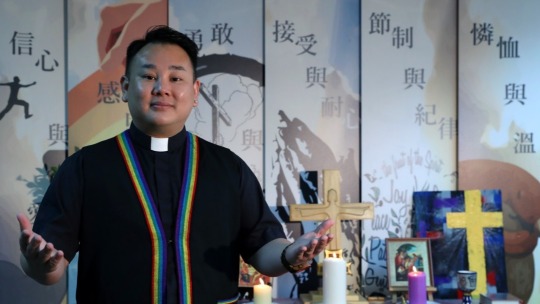
This is Pastor Joe Pang from an LGBTQ inclusive ministry in Hong Kong. He and his congregation were the first ever to worship at the Hong Kong Pride Parade.
Photo Credit: Edmond So
Gay church, rainbow cross welcome LGBT community at Pride Parade. (2018, November 17). Retrieved January 01, 2021, from https://www.scmp.com/news/hong-kong/society/article/2173262/it-ok-be-christian-and-gay-lgbt-church-group-first-be-part
0 notes
Text
Considering New Modes of Being: Asian Liberation Theologies
This was probably the first time I was made to think about new “modes” of being in terms of the ways in which a person can express their sexuality and gender identities. I was also led to queer my ideas of queerness even further to include platonic relationships. This, again, feels like something that should have been obvious to me, but I had not quite thought of friendships in terms of queerness before, at least not beyond the fact that I, and other queer folks, seem to prefer the company of other queers. Another interesting consideration was the idea presented in some of our readings for this unit that Western perceptions and expectations that Asian cultures (broadly) are less progressive actually prevent progress, especially in the form of queer acceptance, from taking place on a larger scale. A simple shift in how we talk and think about Asian cultures would be helpful to Asian communities around the world and social progress.
The idea that probably required the most mental adjustment was that, in some places, the need for peace and harmony, especially concerning family systems, sometimes transcends the need to live an openly queer life. I had to really shift my thought surrounding what it means to live queerly. The first step to this was figuring out how to separate my experiences and desires given my culture and context from the contexts I was learning about as I learned that I was unfairly imposing my need for integrated intersections in several spheres of my life onto groups of people who do not necessarily feel the same way. There are no requirements surrounding queerness that demand queer folks live an obviously out and open life to be considered queer or happy, so why was I allowing it to cloud my understanding of other people.
Another fundamental shift in thinking occurred when I realized that, often, my method of thinking inherently omits platonic relationships from conversations surrounding queerness. Queer friendships and relationships of a non-romantic nature, especially in societies with less overt queer visibility are still queer relations and warrant attention as such. The support and love found in these relationships, and further in communities of platonic friends and acquaintances, is equally, if not more, important for the well-being and formation of the individual as are romantic ones.
I also learned about several similarities between my own context and the Asian contexts about when we learned. Sometimes, legislation is not an accurate reflection of the attitudes of a people. On paper, several places are seemingly very pro or very anti queer identities, but the people there can either be behind or ahead of the legislation passed by lawmakers in their countries. For example, in both the United States and Malaysia, political candidates are at risk of demonization for their sexual identities and gender expression. Coming out publicly tends to bring into question the ability of the candidate to perform in the role of political representative as a queer person. This is where what I mentioned earlier about changing the ways in which we talk about expectations and attitudes of folks in different cultures. If more people expect governing bodies to support the human rights of their citizens, those governing bodies are more likely to make changes and pass legislation accordingly. But if we expect maltreatment and little change, then we are failing as allies.
0 notes
Text
Queering Mary
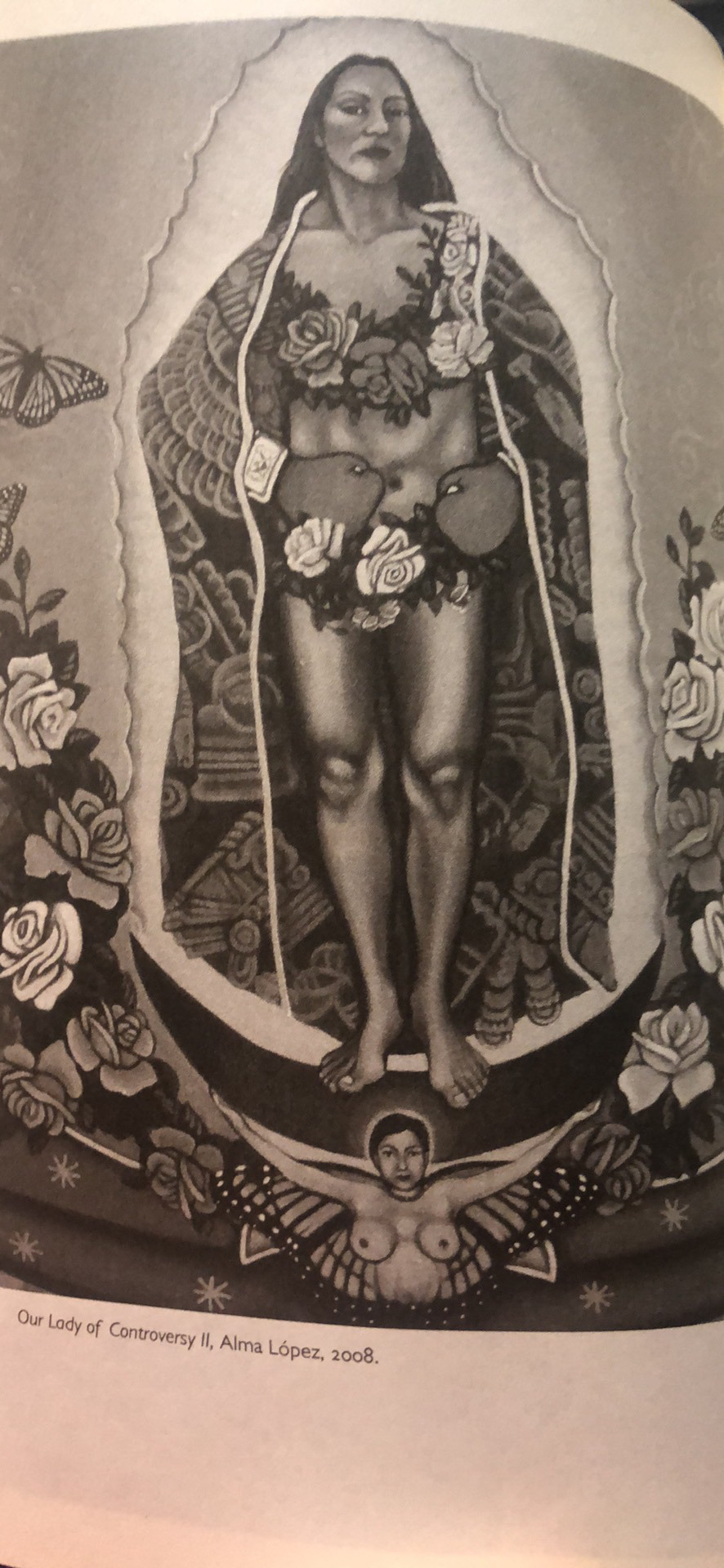
I wanted to share one of my favorite representations of a queered Mary. It is by an artist named Alma López and titled Our Lady of Controversy II. This image depicts Mary showing her body, a stark contrast to traditional depictions of Mother Mary with only her neck, face, hands, and toes showing. She is also looking the audience boldly in the eye and has on boxing gloves, as if she is daring someone to question her. This Mary is also darker skinned, probably closer to what she would have actually looked like, but certainly representative of the artist who depicted her (who, by the way, inserted a small portrait of herself in the space that would traditionally be occupied by a cherub, extending the bounds of the sacred to her own body.
Photo Credits: Our Lady of Controversy II, Alma López, 2008.
Alba, A. G., & López, A. (2012). Our Lady of Controversy: Alma Lopez's "Irreverent Apparition" (pp. 138-139). Austin: University of Texas.
2 notes
·
View notes
Text
Paying Attention To Detail: Latin American Liberation Theologies
Latin American Liberation Theology, or TLL, is fascinating, and I have to open by admitting my ignorance. I had a very narrow view of, very broadly speaking, Latin American culture as being overly Catholic and machismo, two ideas that I honestly have some degree of difficulty reconciling to fit my theology. I could not have been more wrong though. Yes, there are those certain elements present, but they are also present in varying degrees within just about every other society, so I was unfairly throwing out much of the wisdom and experience, capable of enriching my own theological perspectives because of a personal issue with certain perceived elements of culture.
In light of my confession, one big lesson I took away from TLL is that it matters who is doing the talking, and paying attention to that is of crucial importance. This may seem obvious to others, as I feel it should have been to me, but, before this unit on TLL, I never really paid attention to who exactly was doing the theologizing. I trusted, naively, that whoever was writing, especially in cases of TLL, likely had the experience and a deep understanding of their subjects. Clearly, however, as in most theologies, that is not the case. A huge critique of this vein of theology comes from the fact that many see it as a theology about its queer subjects, which is, in this case, usually called “the poor.” (“Poor,” at least within this context, can be queered to include disenfranchised peoples who may not necessarily fit the description of financially poor.) So, I learned to always, always pay attention to who is speaking, what they are speaking about, and the different meanings these and other pieces convey to their intended audiences.
I also quickly learned that many of the perceived issues I had with Latin American theology were largely the fault of colonial and capitalistic influences that made essential the work of men and male-dominated roles while minimizing the roles of women and relegating them to less visible spheres of society. Even though the services traditionally provided by women have seen an increase in demand that parallels the essentialization of the male-centered social and financial sectors.
Another thing I learned is how to better articulate and understand new reasons for queering the bodies and stories of religious figures and how much the small details matter. The example I will use to demonstrate this point is that of the Virgin Mary in many Latin American cultures. Mary represents the ideal woman, a chaste, willing, and obedient servant of God and the perfect example of motherhood. So, to queer this sacred body that has so much influence on the perceptions and expectations society has of women, is to free women and other “queer” (queer here, similarly to “poor” earlier does not necessarily mean gay, it can also be expanded to include other disenfranchised groups) bodies.
1 note
·
View note
Photo
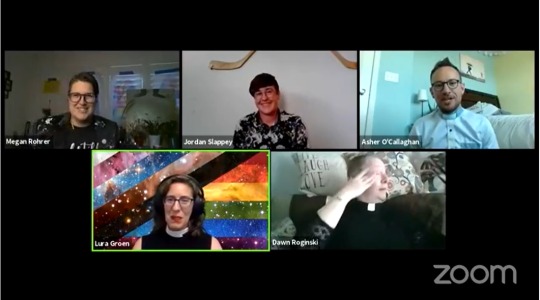
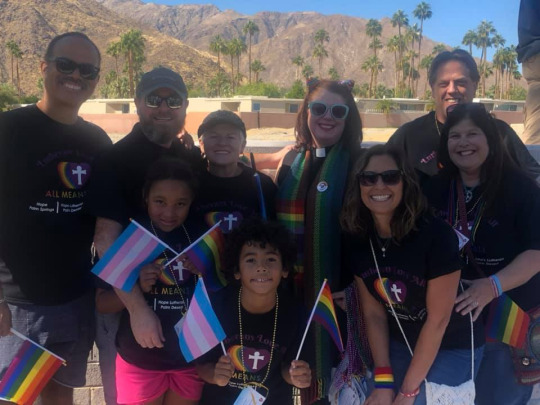
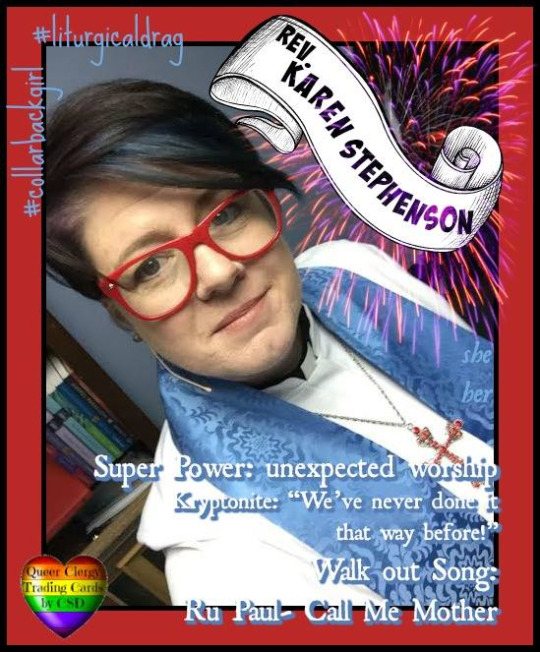

I wanted to post a few personal pictures of queer theology in action from my context. I wanted to represent queer theology in action and give folks a taste of what it is like to be a queer Lutheran (ELCA). The first picture is from a townhall I was a part of (pictured in the top center frame) in which transgender clergy shared what their faith meant to them in light of their queerness and potential strategies for cultivating a more inclusive church. The second picture shows Lutherans in the Coachella Valley celebrating pride, while wearing shirts that put a queer spin on the beloved Lutheran phrase, “all are welcome,” queering the notion of the word all to include queer folks. The third picture is of my mother’s queer clergy card. Queer ELCA Lutherans are given the opportunity to celebrate their ordained status by filling out and sending off for a queer clergy trading card. Queer clergy may trade these with other queer pastors or supply them to interested lay folks, but, either way, it is a fun way for the church to affirm the calls of its queer ministers. The fourth picture is of my mom at Atlanta Pride counter-protesting the conservative evangelical groups that show up to protest the event. She attends yearly to remind queer folks that they are beloved children of God and that the folks who speak hate do not speak for the Lord.
**I either own, or have express permission from the owner (who just so happens to be my mother) of these pictures to use them for this project.
#Queer theology in america#Southern queer theology#queer clergy#all means all or it doesn't#north american queer theology#my context#transgender#queer#theology in action
0 notes
Text
Not so Humble Beginnings: My Introduction to Queer Liberation Theologies
Prior to taking a Queer Liberation Theologies course in my third semester of seminary, I would have been able to give a clear and confident, almost bordering on cocky, answer as to what exactly queer theology was and was not. Now that I have spent a semester learning about just a few of the queer theologies found around the world, however, I am no longer sure of my once self-assured designation. I learned, among other things, that I needed to begin to queer my ideas of queerness and queer theology themselves to make space for less Western (sorry to create a West vs. the Rest line of thinking), and in some cases less American, notions of queerness. I would like to take you on a similar journey that might similarly help you begin to queer your notions of queerness and queer theology as well.
In an effort to get us in the right frame of mind, I am now going to provide the analysis of queer theology I opened the course with and then offer up some critiques of my own musings to get us in the right mindset to queer some of the notions we hold dear. So, here we go:
“For me, theology is an art form – an expression of an individual or, broadly speaking, a community’s faith in God and experience within wider creation. As long as people are still existing and seeking to express their faith in the Divine and relationship to Their creation, I believe that there is still more “waiting to be written.” Additionally, the language that we have to describe experiences, both worldly and sacred, falls far short of being able to adequately express a relationship as complex and whimsical as that between humans and Creator/creation. So, it is also my belief that, as we create more language and methods of expression and grow towards a more intersectional understanding of creation, queer (and other theologies) will continue to be written and lived.
The biggest element driving the development of queer theology, in my mind, is the basis of queer theory itself, which, to put it plainly, is to queer (used here to mean call into question the meaning of) what dominant society deems to be “normal.” To phrase it another way, the term ‘queer’ is being used as a verb, meaning that queer theology is something that you do and live, not just something that is, and if that work is constantly being done, then it must also be continuing to unfold and write itself. Queer theology is lived, and a lived theology is a story with no end.”
Y’all, I was so proud of this definition when I first came up with it. I think there are still some pieces that are worth keeping, but I cannot help but read this analysis and see the heavily Western, colonial influences that frame my thinking. For me, as I was writing this definition, it was so important to categorize and, in plain words, try to pin down exactly what queer and theology meant, but I now see that I was getting in my own way. I am a proponent of just letting queerness be “messy” and undefined, but here I could not just let queerness be (just look, I tried to isolate driving elements, proposed that we come up with new - presumably Western inspired - language to describe it, and reduced the idea to parts of speech), which actually, more than I ever could have realized, leaves out and silences the perspectives of other cultures and peoples.
#queer#queer liberation theology#western context#personal growth#getting started#humility#introduction#queering#queering theology#decolonizing language
1 note
·
View note
Text
Disclaimer
The information communicated here, about Latin American, African, and Asian Liberation Theologies is not anywhere close to a complete picture of the diverse theologies that are a part of the rich tapestry found on each of these continents. There is a lot of geographical, social, political, etc. diversity that my short blog posts simply will not be able to cover or address. This is especially true considering that my goal is to communicate the fundamentals of what I learned from each region as a sort of primer for expanding upon notions of queer theology as I have come to understand them in my Western, specifically North American, context. The hope is that you, the reader, will be able to move on from this blog to engage in additional Liberation Theologies with deeper understandings of some of the nuances present within them.
1 note
·
View note